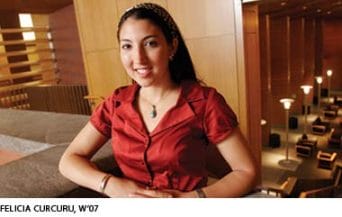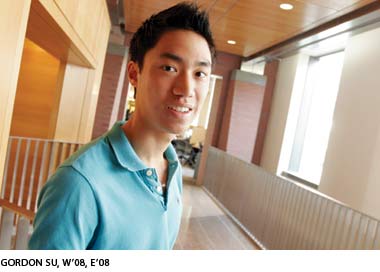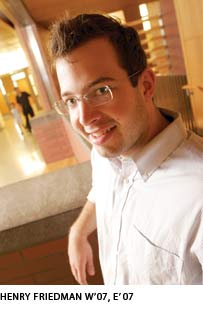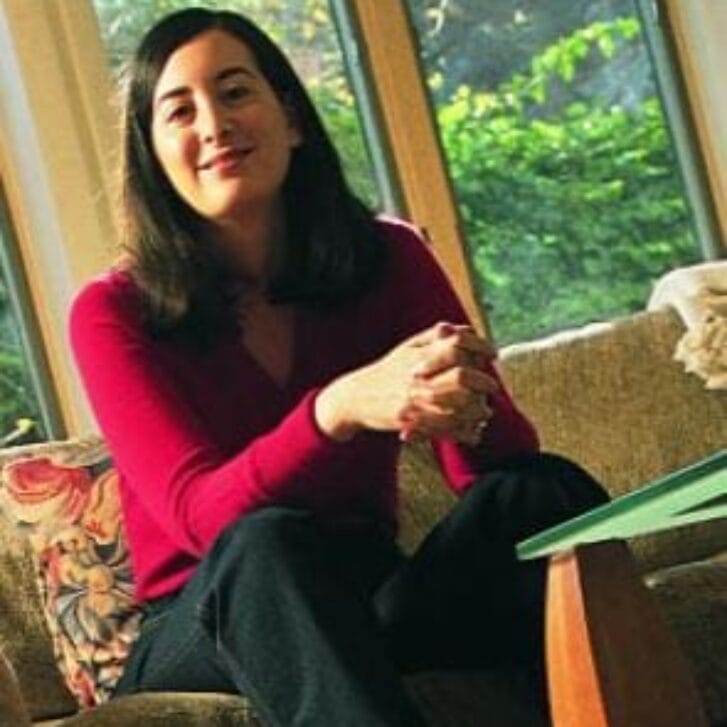Stephen “Blake” Nesbitt’s fascination with pensions began when he was a 15-year-old intern collecting data at Wilshire Associates, where his father Steve Nesbitt, WG’78, worked at the time.
Blake’s summer job was to sift through financial reports and collect data on corporate, state, and municipal pension plans — many of which were Wilshire clients — to help prepare the institutional investment practice’s annual survey of public and private pension systems.
And while his job was simply data collection, his father taught also him about the economics of pension plans and the complicated work of actuaries. “This was my first introduction to the concept of time-value of money and I was absolutely fascinated,” says Nesbitt, W’07. He spent the next two summers at Wilshire getting more and more involved with the annual pension surveys, not realizing that, during those summers, he was collecting data for fiscal years 2000-2002, the main time period of interest for research he would later undertake as a Wharton undergraduate with pension icon and Wharton professor Olivia S. Mitchell — work that would result in a scholarly article that he co-authored.
Nesbitt’s experience is far from unusual among Wharton undergraduate students today, where the rigors of research play a key role.
Undergraduate research takes different forms. Established programs such as the Joseph Wharton Scholars Program, the Benjamin Franklin Scholars Program, and the University Scholars Program, among others, include a research component, as do Independent Study projects and research assistantships. More recently, new programs such as the Wharton Research Scholars Program and the Wharton Summer Research Grants Program brought together funding to offer more Wharton students the chance to dig deep into an area of interest.
In the pages that follow, the Wharton Alumni Magazine talks to a handful of young scholars, whose varied, far-reaching projects set a whole new standard.
Valuing Defined Benefit Pensions
 Nesbitt’s work with Mitchell and co-authors Julia Coronado of Barclays Capital and Steven Sharpe of the Federal Reserve Board updated and extended a 2003 paper that suggested that the market often misvalues companies with defined benefit (DB) pensions because pertinent information on pension finances is relegated to footnotes, a practice that distorts financial statements. Specifically, the study found that stock prices did not reflect the fair market value of pension assets, but instead reflected capitalization rates on pension cost accruals, and that investors failed to differentiate between a firm’s “pension earnings” and its core operating expenses.
Nesbitt’s work with Mitchell and co-authors Julia Coronado of Barclays Capital and Steven Sharpe of the Federal Reserve Board updated and extended a 2003 paper that suggested that the market often misvalues companies with defined benefit (DB) pensions because pertinent information on pension finances is relegated to footnotes, a practice that distorts financial statements. Specifically, the study found that stock prices did not reflect the fair market value of pension assets, but instead reflected capitalization rates on pension cost accruals, and that investors failed to differentiate between a firm’s “pension earnings” and its core operating expenses.
Nesbitt joined Mitchell’s research team to extend this work through 2005, the year the Federal Accounting Standards Board took on pension accounting reform as a result of the recent dramatic swings in DB plans’ financial health. “We wanted to see if investors were still not getting this right,” says Nesbitt, who collected data and maintained the computer programs for the project.
The team found that indeed, investors were still focusing on pension cost accruals in income statements rather than the fair market value of pension assets as reported in financial statement footnotes (hence the paper’s title, “Footnotes Aren’t Enough: The Impact of Pension Accounting on Stock Values”). “The trend was as strong as ever,” Nesbitt says. “It looked as investors never got wise to see past the haze of pension accounting.” The research is especially timely, says Nesbitt, given the FASB’s move in recent years to reform pension accounting standards. The paper is now under review at Review of Accounting Studies, and Nesbitt says it has been an honor to spend his time working side-by-side with Mitchell, “one of the great minds in the insurance and risk management fields.”
As of July, Nesbitt began working at the Blackstone Group’s restructuring and reorganization unit. “It’s especially interesting to me that the current wave of bankruptcies in the airline and auto sectors are partly brought on due to large legacy costs, including pension expenses,” he says.
Examining the Finance in Microfinance
 Felicia Curcuru’s first real glimpse of poverty was during her junior year at Wharton, on a trip to Argentina. Hungry for more information after the trip, Curcuru, W’07, began reading about Grameen Bank founder and Nobel Peace Prize winner Muhammad Yunus and found herself inspired.
Felicia Curcuru’s first real glimpse of poverty was during her junior year at Wharton, on a trip to Argentina. Hungry for more information after the trip, Curcuru, W’07, began reading about Grameen Bank founder and Nobel Peace Prize winner Muhammad Yunus and found herself inspired.
She signed up for a Wharton Field Application project in microfinance, then decided to spend her summer volunteering and doing research at SKS Microfinance in India. Here she connected with Wharton Lauder graduate Jennifer Leonard, WG’00, G’00, then SKS’s CFO. Curcuru pieced together funds from a Wharton Undergraduate Research Grant and a South Asian Studies Department Grant to support her research, which studied the recent trend of microfinance organizations moving from NGOs to for-profit organizations.
SKS couldn’t have been a better example of the trend. Launched in 1998 as an NGO, the company in 2005 transformed to a Non Banking Finance Company (NBFC). A change that brought growth of nearly 300 percent within the past two years.
Curcuru used SKS as a case study for her research and a basis for studying the industry wide trend toward NBFC’s achieving scale and sustainability via global capital rather than relying on grants and subsidies. “While I was working there, SKS was in the process of expanding nationally in India,” Curcuru says. “Within less than one year, it has grown to over 700,000 clients. SKS was also expanding product offerings to include individual loans for more advanced clients and health and livestock insurance, as well as moving from only rural lending to urban lending. It was a very exciting time to be there.”
Because of their Wharton connection, Curcuru worked closely with Leonard and lived with her while in India. She was also able to assist with SKS’s five-year business plan for investors, which the management team was in the process of creating when she arrived. “I helped to build the financial projections for the business plan, which was a great experience for me and forced me to understand the revenue and cost side of every part of the business and every product, as well as their capital needs,” Curcuru says.
But little compared to the experience of visiting rural villages in Andhra Pradesh. Curcuru met the women behind the small loans — typically less than $100 — the loans to buy a cow, goat, or buffalo with milk to sell, a popular income generating activity for the poor in India. “Hearing their stories was extremely powerful and put meaning behind the numbers I looked at most days,” she says.
Curcuru’s final research paper, her Joseph Wharton Scholars senior research project, was titled “The Microfinance Transformation: A Shift Toward Profitability and Sustainable Growth,” and charts microfinance’s evolution and future. As MFIs continue to transform into for-profit institutions, Curcuru writes, an industry once dominated by nonprofits and supported by grants and government subsidies will behave more like banking and investment companies and will likewise be funded by profit-seeking investors.
The industry will consolidate, with the largest and most profitable MFIs dominating and with traditional banks moving downstream to become more directly involved with microfinance services. MFIs will begin to compete for both clients and investors. “Although only 2 percent of the more than 3,000 microfinance organizations in the world are financially self-sustainable, these few MFIs will dominate the future of the microfinance industry as they continue to scale at extraordinary rates,” Curcuru writes.
But challenges to the industry’s future growth remain, the paper continues. Very few MFIs are profitable enough to offer returns on investment, and those that do are largely far below investment alternatives in the public or private equity markets. Another challenge is the reality that, because most MFIs are still nonprofits, their reporting is largely unregulated, allowing many MFIs to manipulate and obscure data, Curcuru writes. And investors continue to view microfinance as exposed to risks such as natural disasters, currency, and political risk. Curcuru also cites the potential that heightened competition for funds among MFIs may result in a “mission creep” as pressure to deliver financial return to investors increases.
Though she initially felt she would work for an NGO immediately after graduating from Wharton, Curcuru changed her mind after working with SKS founder and CEO Vikram Akula, who started his career at McKinsey, as well as other colleagues she worked with at SKS. She will join McKinsey’s Miami office in January after traveling and working in China this fall. “I realized I should get into it a little later on, when I’m trained and a little more able to make things happen,” she says.
The Impact of Second-Lien Loans
 Gordon Su, W’08, E’08, traces his fascination with the credit markets to reading as a teen about Michael Milken, WG’70, and the high-flying 1980s, when Milken played a pivotal role in creating the junk bonds market.
Gordon Su, W’08, E’08, traces his fascination with the credit markets to reading as a teen about Michael Milken, WG’70, and the high-flying 1980s, when Milken played a pivotal role in creating the junk bonds market.
And so as he listened last year at a Wharton Private Equity conference to speakers describing the exploding secondlien loan market as the best example of the excesses in today’s credit markets, he was intrigued. The speakers wondered what would happen when “we go through the next credit cycle, but now we have these second-lien loans instead of highyield bonds in the capital structure,” recalled Su, a senior in the Jerome Fisher Program in Management and Technology. “No one really knew. It was a big question.”
Curious, he searched the literature, and was struck by the second-lien loan market’s stratospheric growth — from an issuance of $300 million in the late 1990s to more than $22 billion in 2005 — but found no published research on possible future implications. He decided to tackle the issue for an Independent Study project, focusing his research on the impact second-lien loans may have on future bankruptcies. Su’s resulting article, “Bankruptcy Implications of Second Lien Loans,” recently won the Turnaround Management Association’s (TMA) 2007 Carl Marks Student Paper Competition and will be published in TMA’s October Issue of Journal of Corporate Renewal.
Working closely with bankruptcy expert and Penn Law professor David A. Skeel Jr., Su studied the 14 most recent bankruptcy cases involving second-lien loans. These cases, Su felt, provided enough information to come up with some key takeaways.
First, second-lien loans appear to have replaced unsecured debt as the fulcrum security in bankruptcy cases. “Distressed debt investors need to be aware of this change,” Su says.
Su also found that that second-lien loans, because of their secure nature, allow distressed debt investors to exercise an unusual amount of control over the bankruptcy process. “My research reveals that bankruptcies with second-lien loans mostly involve debtors with over-encumbered balance sheets,” Su writes in his paper’s abstract. “The result is that second-lien loans have created significant barriers to reorganizations by: 1. limiting free assets to operate in bankruptcy and collateralize Debtor-In-Possession financing; 2. limiting reorganization options by making “cram-downs” (when a creditor is forced to accept certain reorganization terms) more difficult; and 3. introducing new hedge-fund related complexities to the reorganization process.” In general, the power shifts more toward creditors, which may result in more liquidations, asset sales, and a shift toward nontraditional players such as hedge funds dictating the bankruptcy process, Su says.
Su believes that while second-lien issuance may decline if credit markets tighten and interest rates rise, the second-lien market’s vast size and growing liquidity are signs of its longterm staying power. In the coming years, Su writes, hedge funds and distressed debt funds are likely to dominate the impact of second-lien loans on reorganizations. “Hedge fund involvement should not intensify reorganization efforts but may actually, on net, alleviate potential inter-creditor conflicts.”
“The research experience was different from taking classes at Wharton because it gave me a real opportunity to take a deep dive on a subject instead of glossing over many,” Su says. “I also had the opportunity to talk and interact with professionals, who definitely think more practically rather than theoretically. Finally, since my topic is not that well covered, my research project forced me to think hard about the implications and consequences of what will happen (and not having a right answer), which is quite a different exercise than learning.”
Su spent the summer in San Francisco and New York working at KKR Financial, the credit investment vehicle of the private equity firm Kohlberg Kravis Roberts, where he observed the implications of his research first hand. “With the meltdown in credit markets this summer, my internship couldn’t have been better timed since I have been able to work on some real distressed debt in the loan market,” he says, noting that that Milken’s interest in high-yield bonds began with a paper he wrote as a student at Penn. “It’s interesting today that I find myself so interested in credit — things seem to be coming full circle.”
Examining Investor Overconfidence
 Henry Friedman, W’07, E’07, describes his research project on the effect of overconfidence on entrepreneurial investment choices as an entirely new way of learning that forced him to come at his conclusions from a variety of angles, because “everyone is trying to poke holes in your argument.”
Henry Friedman, W’07, E’07, describes his research project on the effect of overconfidence on entrepreneurial investment choices as an entirely new way of learning that forced him to come at his conclusions from a variety of angles, because “everyone is trying to poke holes in your argument.”
“The arguments have to be very strong and communicated in as concise a way as possible,” he says. “You have got to check your results in several different ways. The standards are just much, much higher.”
Friedman paired with Accounting Professor Gavin Cassar after taking a managerial accounting class with him in the fall of 2005. Initially, he worked as Cassar’s research assistant, then applied and got into the Wharton Research Scholars Program with Cassar as his faculty mentor.
Using data from the Panel Study of Entrepreneurial Dynamics, a longitudinal survey of entrepreneurs that provides data on entrepreneurial investment and relevant psychological information, the two found that individual overconfidence is associated with more aggressive entrepreneurial investment decisions. “The major takeaway is that we connect psychological factors to economic decisions,” Friedman says.
More specifically, overconfident entrepreneurs were more likely to spend money on costly investments before investing in planning activities. Overconfidence was also found to reduce external funding amounts and increase human capital expenses, though Friedman and Cassar found no relationship between overconfidence and investment risk.
“Managers and entrepreneurs can benefit from understanding that overconfidence leads to more aggressive decisions generally,” Friedman and Cassar write in Does Overconfidence Affect Entrepreneurial Investment? “In situations where aggressive decisions may be detrimental, managers and entrepreneurs can use formal decision-making methods, decision checks or teams to closely monitor and control the effects of an individual’s overconfidence.
“Alternatively, (they) can allow overconfidence to flourish among decision-makers in situations where aggressiveness is beneficial.” Friedman and Cassar have presented their work at two academic conferences; their goal is to publish the research.
Friedman grew up assuming he would become an engineer, then learned about the Management and Technology Program, where he applied and was accepted early admission. “I initially came at it from the engineering side,” assuming he would get a PhD in engineering and go into industry. But during his years at Wharton, he began to appreciate business as a social science.
And his research experience with Cassar became a key to his recent decision to become a business professor. After graduating last spring, Friedman applied to PhD programs at Stanford and Wharton, and was accepted to both. This fall, he returns to Wharton as a PhD student. “It seems that undergraduate research is starting to gain support, and that’s a really good thing,” he says. “It’s a good way to learn. The standards are just completely different.
Nancy Moffitt is a frequent contributor to Wharton Alumni Magazine.


























